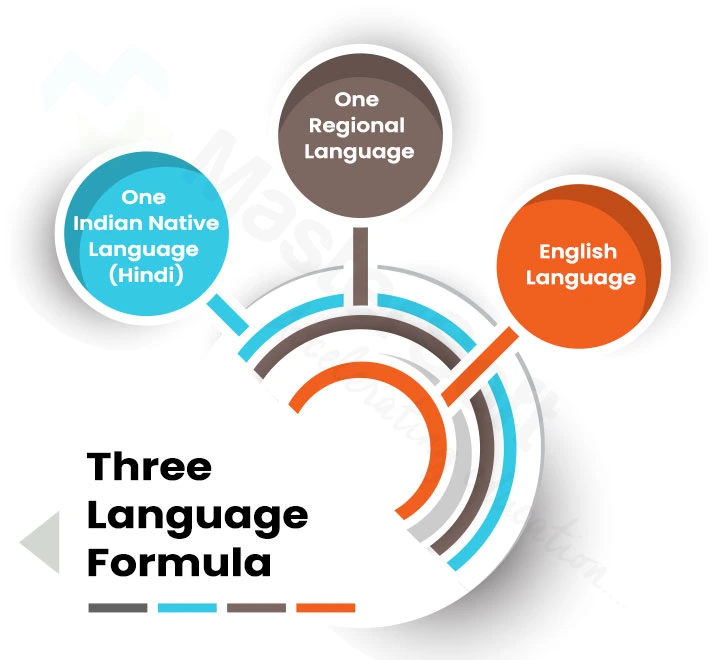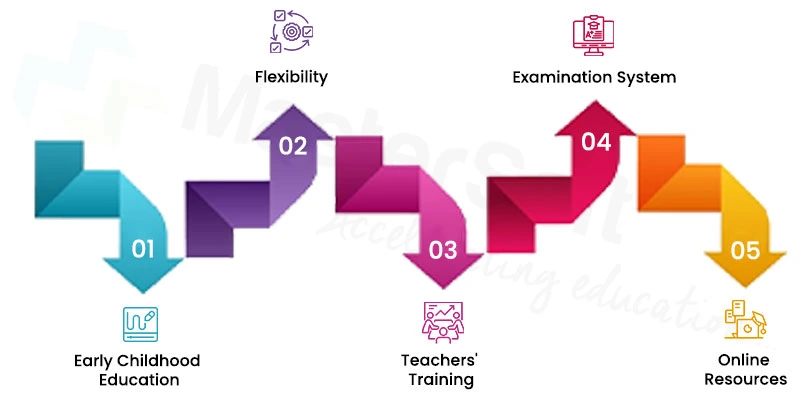22, May 2023
The 1961 meeting of the several chief ministers of the Indian states resulted in a consensus that led to the implementation of the three-language formula. The Three-Language Formula was intended to be a handy starting point for the examination of the country's developing knowledge base and emotional integration, rather than a goal or restriction on language learning.
The three-language formula has been advocated for by NEP 2020 in order to promote multilingualism and strengthen national unity. The argument over whether the three language formulas are appropriate across India has been reopened by this action. The Chief Minister of Tamil Nadu rejected it, and it merely reaffirmed the state's staunch stance on a sensitive and political matter.
What is the Three Language Formula?

The Three Language Formula states that every student in India should learn three languages: two of which should be native Indian languages, including one regional language, and the third should be English. The formula is applicable to both government and private schools, and the medium of instruction can be any of the three languages.
The national education policy of 1968 introduced the three-language formula, meaning that apart from Hindi and English, there should be a third language which is a part of modern India and must be used for education in Hindi-speaking states.
Three Language Formula:
- One Indian Native Language (Hindi)
- One Regional Language
- English Language
The primary aim of the Three Language Formula is to promote multilingualism in India and enable students to communicate effectively across the country. It also aims to strengthen national integration by exposing students to different cultures and languages and fostering respect for linguistic diversity.
National Education Policy 2020 For Schools
Issues Related to the Three Language Formula:
- Even though the Three Language Formula allows for the teaching of the mother tongue languages, the emphasis is lost because of inconsistent implementation.
- While defending the political rights of major ethnic groups, this approach falls short of preventing the extinction of various mother tongues.
- Sanskrit study is mandated in some places for students.
- Due to the three language formula, students now have an increased burden of subjects.
- The draft policy appears to rely on its support for Hindi on the assumption that 54% of Indians can speak it.
- However, 52 crore out of 121 crore persons claimed Hindi as their language of speaking in the 2001 Census, while about 32 crore claimed Hindi as their mother tongue. This indicates that less than 44% of Indians speak Hindi, and only slightly more than 25% of Indians speak Hindi as their mother tongue.
- However, there has been more pressure to make Hindi the official language of India, which many states, particularly those in the South, view as an imposition of Hindi.
- States like Tripura, Tamil Nadu, and Puducherry were not prepared to teach Hindi, while states that speak Hindi did not include any South Indian languages in their curriculam.
- State governments frequently lack the funding necessary to put the three language formula into place.
- The most significant component of the difficulty is the lack of resources. Investing in so many language teachers in such a short period of time will be very challenging for state governments with limited resources.
NEP 2020 New Academic Structure Explained - 5+3+3+4 Education System
What is The Need for Three Language Formula?
The report of the committee notes that a child's cognitive growth includes acquiring languages, which is significant. Promoting multilingualism and international concord is the main goal.
It further helps with:- Bridging the linguistic gap and enabling effective communication across the country.
- Providing career opportunities and a competitive edge in the job market through proficiency in English.
- Fostering respect for linguistic and cultural diversity.
- Promoting the use and learning of regional languages can help preserve them for future generations.
- Enhancing cognitive development through learning multiple languages
Implementation of the Three Language Formula in NEP 2020:
A comprehensive foundation for implementing the Three Language Formula in Indian schools is provided under NEP 2020. The following are the policy's key points:

Early Childhood Education:
The policy places a strong emphasis on the value of early childhood education in helping children learn languages. It suggests that kids between the ages of 3 and 8 study in their native language or a regional tongue.
Flexibility:
The policy permits a wide range of language options. The third language can be English or any other language of the student's choice, while the first two languages must be native Indian languages from their state or region. In non-Hindi-speaking states, where there have been worries about the imposition of Hindi, this clause is anticipated to lessen opposition to the formula.
Teachers' Training:
The policy acknowledges the necessity of trained educators in order to successfully apply the Three Language Formula. It suggests that teachers be given multilingualism training and that attempts be made to find teachers fluent in the local tongues.
Examination System:
According to the policy, students should be evaluated on their command of all three languages, including English.
Online Resources:
To enable students to learn in their native tongues, the policy encourages the creation of online resources and instructional materials in native Indian languages.
History of the Three Language Formula
- Different parts of the country have different educational systems.
- Regional languages and English were used as the primary teaching languages in other regions, although Hindi served as the primary language of instruction in the north.
- Communication between states was made difficult, which resulted in chaos.
- So, in 1968, the New Education Policy came up with a compromise known as the Three-Language Formula in order to standardise the system.
- The National Education Policy of 1968 defined the three-language formula as the usage of a third language (in addition to Hindi and English) that should be a component of modern India for educational purposes in Hindi-speaking states.
- Regional languages and English will also be used in states where Hindi is not the official language.
- The National Education Policy of 1968 defined the three-language formula as the usage of a third language (in addition to Hindi and English) that should be a component of modern India for educational purposes in Hindi-speaking states.
- Regional tongues and English will also be used in states where Hindi is not the official language.
- The Kothari Commission (1966–1966) modified and updated this method to take into account the regional languages and mother tongues of the group identities. At the two ends of the queue, Hindi and English were still present.
- Students should learn their mother tongue or a local language as their first language.
- The second language would be English or another modern Indian language in Hindi-speaking areas. This will either be in Hindi or English in non-Hindi states.
- The third language, which is not selected as the second language, would be English or another modern Indian language in Hindi-speaking regions. This will be English or another modern Indian language in non-Hindi states, but it will not be the second language chosen.
- Additionally, the NEP of 1986 reproduced identically the policies of 1968 on the three-language formula and the promotion of Hindi, making no changes to them.
NEP 2020 Views on the Three Language Formula:
The home language, mother tongue, local language, or regional language will, whenever possible, be the medium of instruction up until at least Grade 5, but preferably up to Grade 8 and beyond. The three-language formula will still be used, but it will be done so while promoting both national unity and multilingualism.
This system will have more freedom, according to NEP, and no state will be forced to use a certain language. So long as at least two of the three languages are indigenous to India, states, or regions, and of course, the students themselves will choose the three languages that will be taught to them.
Summing Up,
The purpose of the three language formula is to bridge the linguistic divide between the states and promote national unity. The ethnic diversity of India can be included in other ways as well, though.
Even without implementing the three language formula, states like Tamil Nadu with their own language policies have been able to improve educational standards while simultaneously fostering national integrity. As a result, giving the states control over their language policies seems like a much better alternative than uniformly imposing the three-language formula throughout India.
Connect With MasterSoft - Your One-Stop ICT Solutions Aligned With NEP 2020
Mobile: 08448010216
Email:info@mastersofterp.com













